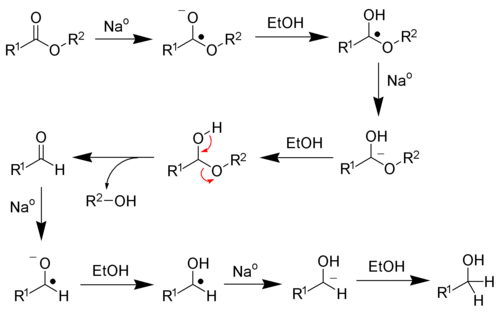Bouveault–Blanc reduction
The Bouveault–Blanc reduction is a chemical reaction in which an ester is reduced to primary alcohols using absolute ethanol and sodium metal.[1] It was first reported by Louis Bouveault and Gustave Louis Blanc in 1903.[2][3][4] Bouveault and Blanc demonstrated the reduction of ethyl oleate and n-butyl oleate to oleyl alcohol.[5] modified versions of which were subsequently refined and published in Organic Syntheses.[6][7][8]
| Bouveault-Blanc reduction | |
|---|---|
| Named after | Louis Bouveault Gustave Louis Blanc |
| Reaction type | Organic redox reaction |
| Identifiers | |
| Organic Chemistry Portal | bouveault-blanc-reduction |
| RSC ontology ID | RXNO:0000119 |
This reaction is used commercially although for laboratory scale reactions it was made obsolete by the introduction of lithium aluminium hydride.[1]
Reaction mechanism
Sodium metal is a one-electron reducing agent. Four equivalents of sodium are required to fully reduce each ester. Ethanol serves as a proton source.[1] The reaction produces sodium alcoxides, according to the following stoichiometry:
- RCOOR' + 6 Na + 4 CH
3CH
2OH → RCH
2ONa + R'ONa + 4 CH
3CH
2ONa
In practice, considerable sodium is consumed by the formation of hydrogen. For this reason, an excess of sodium is often required. Because the hydrolysis of sodium is rapid, not to mention dangerous, the Bouveault-Blanc reaction requires anhydrous ethanol.[9][8] The mechanism of the reaction follows:[1]
Consistent with this mechanism, sodium-ethanol mixtures will also reduce ketones to alcohols.[10]
This approach to reducing esters was widely used prior to the availability of hydride reducing agents such as lithium aluminium hydride and related reagents. It requires vigorous reaction conditions and has a significant risk of fires, explaining its relative unpopularity. One modification involves encapsulating the alkali metal into a silica gel, which has a safety and yield profile similar to that of hydride reagents.[11] Another modification uses a sodium dispersion.[12][13]
See also
- Acyloin condensation – The reductive coupling of esters, using sodium, to yield an α-hydroxyketone
- Akabori amino-acid reaction – The reduction of amino acid esters, by sodium, to yield aldehydes
- Birch reduction – For the reduction of alkenes using sodium
- Bouveault aldehyde synthesis – Another organometallic reaction by Bouveault where a Grignard reagent is converted to an aldehyde
References
- Wang, Zerong, ed. (2009). "109. Bouveault–Blanc Reduction". Comprehensive Organic Name Reactions and Reagents. pp. 493–496. doi:10.1002/9780470638859.conrr109. ISBN 978-0-471-70450-8.
- Bouveault, L.; Blanc, G. (1903). "Préparation des alcools primaires au moyen des acides correspondants" [Preparation of primary alcohols by means of the corresponding acids]. Compt. Rend. (in French). 136: 1676–1678.
- Bouveault, L.; Blanc, G. (1903). "Préparation des alcools primaires au moyen des acides correspondants" [Preparation of primary alcohols by means of the corresponding acids]. Compt. Rend. (in French). 137: 60–62.
- Bouveault, L.; Blanc, G. (1904). "Transformation des acides monobasiques saturés dans les alcools primaires correspondants" [Transforming saturated monobasic acids into the corresponding primary alcohols]. Bull. Soc. Chim. Fr. (in French). 31: 666–672.
- Bouveault, L.; Blanc, G. (1904). "Hydrogénation des éthers des acides possédant en outre les fonctions éther-oxyde ou acétal" [Hydrogenation of the ether of the acids furthermore possessing the ether-oxide or acetal functions]. Bull. Soc. Chim. Fr. (in French). 31 (3): 1210–1213.
- Reid, E. E.; Cockerille, F. O.; Meyer, J. D.; Cox, W. M.; Ruhoff, J. R. (1935). "Oleyl Alcohol". 15: 51. doi:10.15227/orgsyn.015.0051. Cite journal requires
|journal=(help) - Adkins, Homer; Gillespie, R. H. "Oleyl alcohol". 29: 80. doi:10.15227/orgsyn.029.0080. Cite journal requires
|journal=(help) - Ford, S. G.; Marvel, C. S. (1930). "Lauryl Alcohol". Organic Syntheses. 10: 62. doi:10.15227/orgsyn.010.0062.
- R. H. Manske (1934). "Decamethylene Glycol". Organic Syntheses. 14: 20. doi:10.15227/orgsyn.014.0020.
- Whitmore, Frank C.; Otterbacher, T. (1930). "2-Heptanol". Organic Syntheses. 10: 60. doi:10.15227/orgsyn.010.0060.
- Bodnar, Brian S.; Vogt, Paul F. (2009). "An Improved Bouveault-Blanc Ester Reduction with Stabilized Alkali Metals". J. Org. Chem. 74 (6): 2598–2600. doi:10.1021/jo802778z. PMID 19219971.
- An, Jie; Work, D. Neil; Kenyon, Craig; Procter, David J. (2014). "Evaluating a Sodium Dispersion Reagent for the Bouveault–Blanc Reduction of Esters". J. Org. Chem. 79 (14): 6743–6747. doi:10.1021/jo501093g. PMID 24941291.
- Han, Minhui; Ma, Xiaodong; Yao, Shangchu; Ding, Yuxuan; Yan, Zihan; Adijiang, Adila; Wu, Yufei; Li, Hengzhao; Zhang, Yuntong; Lei, Peng; Ling, Yun; An, Jie (2017). "Development of a Modified Bouveault–Blanc Reduction for the Selective Synthesis of α,α-Dideuterio Alcohols". J. Org. Chem]. 82 (2): 1285–1290. doi:10.1021/acs.joc.6b02950. PMID 28029787.

